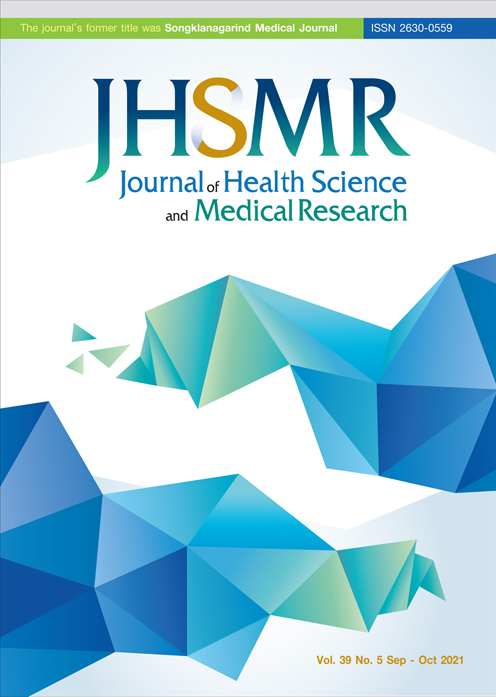Factors Associated with Moderate to Severe Pain after Laparoscopic Surgery
DOI:
https://doi.org/10.31584/jhsmr.2021792Keywords:
factors, moderate to severe pain, laparoscopic surgeryAbstract
Objective: The aim of this study was to describe associated factors of patients with moderate to severe pain after laparoscopic abdominal surgery in Post Anesthetic Care Unit.
Material and Methods: This retrospective study included patients who underwent laparoscopic abdominal surgeries (bariatric, colorectal, gynecological, urological, and upper gastrointestinal surgery) between February and July 2019. Demographic data were retrieved from the anesthetic records. Pain score was evaluated by self- rating using verbal numerical rating scale (0-10). Logistic regression was used to obtain independent risk factors of moderate to severe (score 4-10) pain against no or mild pain.
Results: Two-hundred and ten patients were included. The incidence of moderate (score 4-6) to severe pain (score 7-10) was 50.0%. Those who suffered from moderate to severe pain required higher consumption of analgesic drugs in recovery room than the other groups, however durations of hospitalization were not different between the two groups (p-value=0.329). This was because the highest intensity of pain was in the first postoperative day. A multivariate logistic regression analysis revealed that abdominal pressure more than 12 mmHg (odd ratio (OR)=1.84, 95% confidence interval (CI) 0.8-4.22, p-value=0.153), and operation time more than 3 hours (OR 1.49, 95% CI 0.86-2.61, p-value=0.158) were independent risk factors of moderate to severe pain after laparoscopic procedure
Conclusion: High intra-abdominal pressure (≥12 mmHg) and prolonged operation time (>3 hours) are the independent risk factors of moderate and severe pain in laparoscopic surgery.
References
Gan TJ. Poorly controlled postoperative pain: prevalence, consequences, and prevention. Pain Res 2017;10:2287–98.
Ekstein P, Szold A, Sagie B, Werbin N, Klausner JM, Weinbroum AA. Laparoscopic surgery may be associated with severe pain and high analgesia requirements in the immediate postoperative period. Ann Surg 2006;243:41–6.
Adenekan AT, Aderounmu AA, Wuraola FO, Owojuyigbe AM, Adetoye AO, Nepogodiev D, et al. Feasibility study for a randomized clinical trial of bupivacaine, lidocaine with adrenaline, or placebo wound infiltration to reduce postoperative pain after laparoscopic cholecystectomy. BJS 2019;26:5.50159.
Silva LM da, Kakuda CM, Abib A de CV, Fugiwara FY, Lara GFL e, Mazzotta RC, et al. Fatores associados dor p s-operat ria na recupera o p s-anest sica em pacientes submetidos gastroplastia laparosc pica. Rev Dor 2013;14: 239–44.
Ip HYV, Abrishami A, Peng PWH, Wong J, Chung F. Predictors of postoperative pain and analgesic consumption: a qualitative systematic review. Anesthesiology 2009;111:657–77.
Zeidan A, Al-Temyatt S, Mowafi H, Ghattas T. Gender-related difference in postoperative pain after laparoscopic Roux-En-Y gastric bypass in morbidly obese patients. Obes Surg 2013; 23:1880–4.
Hartwig M, Allvin R, B ckstr m R, Stenberg E. Factors associated with increased experience of postoperative pain after laparoscopic gastric bypass surgery. Obes Surg 2017; 27:1854–8.
Özdemir-van Brunschot DMD, van Laarhoven KCJHM, Scheffer GJ, Pouwels S, Wever KE, Warl MC. What is the evidence for the use of low-pressure pneumoperitoneum? A systematic review. Surg Endosc 2016;30:2049–65.
Hsien CF, Wang CL, Long CY, Chen YH, Lee WYN, Chen SC, et al. Factors associated with types and intensity of postoperative pain following gynecological laparoscopic surgery: a cross-sectional study. Biomed Res Int 2017;2017. doi:10.1155/2017/2470397.
Sugihara M, Miyake T, Miyagi Y, Oda T, Hazama Y, Sano R, et al. Does local infiltration anesthesia on laparoscopic surgical wounds reduce postoperative pain? Randomized control study. Reprod Med Biol 2018;17:474–80.
Kamali A, Ashrafi TH, Rakei S, Noori G, Norouzi A. A comparative study on the prophylactic effects of paracetamol and dexmedetomidine for controlling hemodynamics during surgery and postoperative pain in patients with laparoscopic cholecystectomy. Medicine (Baltimore) 2018;97. doi: 10.1097/ MD.0000000000013330.
Liu Y, Song X, Sun D, Wang J, Lan Y, Yang G, et al. Evaluation of intravenous parecoxib infusion pump of patient-controlled analgesia compared to fentanyl for postoperative pain management in laparoscopic liver resection. Med Sci Monit 2018;24:8224–31.
Akkoc A, Topaktas R, Aydin C, Altin S, Girgin R, Yagli OF, et al. Which intraperitoneal insufflation pressure should be used for less postoperative pain in transperitoneal laparoscopic urologic surgeries? Int Braz J Urol Off J Braz Soc Urol 2017;43:518–24.
Top u HO, Cavkaytar S, Kokanalı K, Guzel AI, Islimye M, Doganay M. A prospective randomized trial of postoperative pain following different insufflation pressures during gynecologic laparoscopy. Eur J Obstet Gynecol Reprod Biol 2014;182: 81–5.
Choi JB, Kang K, Song MK, Seok S, Kim YH, Kim JE. Pain characteristics after total laparoscopic hysterectomy. Int J Med Sci 2016;13:562–8.
Atkinson TM, Giraud GD, Togioka BM, Jones DB, Cigarroa JE. Cardiovascular and ventilatory consequences of laparoscopic surgery. Circulation 2017;135:700–10.
Iamaroon A, Tangwiwat S, Nivatpumin P, Lertwacha T, Rungmongkolsab P, Pangthipampai P. Risk factors for moderate to severe pain during the first 24 hours after laparoscopic bariatric surgery while receiving intravenous patient-controlled analgesia. Anesthesiol Res Pract 2019. doi: 10.1155/2019/6593736.
de Hoogd S, V litalo PAJ, Dahan A, van Kralingen S, Coughtrie MMW, van Dongen EPA, et al. Influence of morbid obesity on the pharmacokinetics of morphine, morphine-3-glucuronide, and morphine-6-glucuronide. Clin Pharmacokinet 2017;56: 1577–87.
Nada EM, Alabdulkareem A. Morphine versus fentanyl patientcontrolled analgesia for postoperative pain control in major hepatic resection surgeries including living liver donors: A retrospective study. Saudi J Anaesth 2018;12:250–5.
Anestez Z. A new goal in opioid management in obese patients: opioid free anesthesia. Anestezi Dergisi 2017;25:117- 21.
Downloads
Published
How to Cite
Issue
Section
License

This work is licensed under a Creative Commons Attribution-NonCommercial-NoDerivatives 4.0 International License.
























